How to Size a Residential Air Conditioner?
 When it comes to buying a new air conditioner for your home, getting the size right is important. If you go for a system which is too small then you’ll struggle to regulate the temperature, go too big and you’ll incur extra costs which aren’t needed and it could actually wear out faster. The first point to make is that when you are buying a new air conditioning unit, getting some professional support is always a great idea. The first place to start however, is to get a rough guide as to what kind of size you will need for your home.
When it comes to buying a new air conditioner for your home, getting the size right is important. If you go for a system which is too small then you’ll struggle to regulate the temperature, go too big and you’ll incur extra costs which aren’t needed and it could actually wear out faster. The first point to make is that when you are buying a new air conditioning unit, getting some professional support is always a great idea. The first place to start however, is to get a rough guide as to what kind of size you will need for your home.
To help you get that sizing right, here are some tips on making an accurate estimate.
How Air Conditioning Units Are Sized
The way in which AC units are professionally sized is through the metric of tonnage. The tonnage refers to the amount of BTUs which the AC units can take out of the air. BTU stands for British Thermal Unit, and the tonnage essentially measures the ability of the AC system to remove heat from the air, each hour.
Calculating An Approximate Size For Your Air Conditioner
Determining the square footage of the space which you want to cool is the first place to start. Understand the floor space of your home, which should be available through your original house plans or, if you do not have them, then by measuring the rooms out with a tape measure. Remember that the only space which you should be measuring is that which you want to cool down. Measuring the length and width of each room, and then multiplying the two numbers together will give you the square footage for that room. Do this in each room and then add them all together.
Getting Your BTU Measurement
Once you have measured the square footage of your home it is time to multiply that number by 25, this will give you the base BTU which you need. One note to make here is that if you have ceilings which are higher than 8 feet, be sure to multiply the BTU number you have by 1.25, to account for the additional space.
Example of Converting BTUs to AC Units
If you take the example of a home which is 1500 square feet, with average sized ceilings. This would result in a BTU base unit of 37,500. With this number you can then work out what tonnage the AC unit needs to be in order to effectively cool the space. To do this simply divide the number by 12,000, in this case the air conditioner is capable of 3 tonnes per hour.
When it comes to air conditioning solutions this may all sound slightly complex, but if you stick to the calculations in this post you will be able to get a solid idea as to what you need for your home. Always double check with a professional before you pull the trigger and buy an AC unit, but these figures can give you a head start when looking at options for your new AC.









